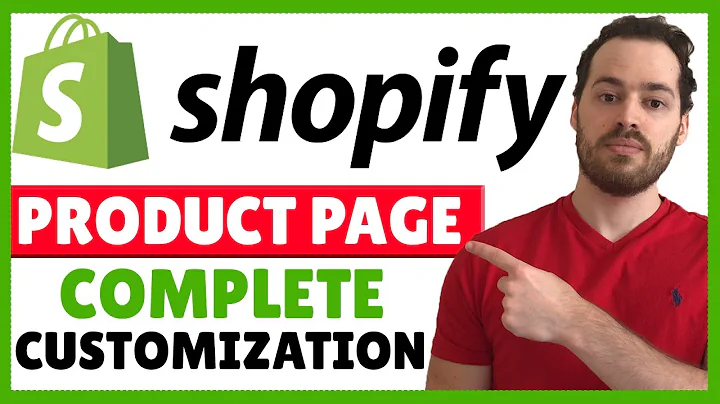Unlocking Success with Google Ads: Strategies for E-commerce Owners
Table of Contents:
- Introduction
- The Importance of Google Ads for Driving Traffic
- The Benefits of Organic Traffic and SEO
- Using a Combination of Paid Ads and Organic Traffic
- Understanding Negative Keywords
- How to Identify Negative Keywords
- The Importance of Regularly Optimizing Your Campaigns
- Increasing the Budget for High Performing Products
- Excluding Low Performing Products from the Campaign
- The Skill and Knowledge Required for Running Google Ads
- The Importance of Proper Account Setup and Conversion Tracking
- Conclusion
Article:
The Secrets to Success with Google Ads: What Every E-commerce Business Owner Should Know
In the ever-evolving digital landscape, knowing how to effectively drive traffic to your online business is crucial for success. One of the most powerful tools at your disposal is Google Ads. With its vast reach and targeting capabilities, Google Ads can help you attract the right audience and boost your sales. However, like any marketing strategy, there are certain things you need to know and be mindful of to make the most out of Google Ads.
1. Introduction
As an e-commerce business owner, you may have already dabbled with Google Ads or are considering using it to drive traffic to your online store. In this article, we will uncover the secrets to success with Google Ads and provide you with valuable insights that could save you time, money, and frustration.
2. The Importance of Google Ads for Driving Traffic
When it comes to driving traffic to your online business, there are two main avenues: paid ads and organic traffic. While organic traffic generated through search engine optimization (SEO) is valuable, Google Ads can offer immediate visibility and quicker scalability.
Paid advertising channels like Facebook Ads, TikTok Ads, and Instagram Ads certainly have their merits, but Google Ads remains a dominant force in the advertising world. With billions of searches conducted on Google every day, leveraging Google Ads can put your products or services in front of a massive audience.
3. The Benefits of Organic Traffic and SEO
While paid advertising can drive immediate results, organic traffic generated through SEO is not to be overlooked. Search engine optimization involves optimizing your website's backend and content to improve its visibility in search engine results pages (SERPs).
In addition to paid ads, Google displays organic search results based on relevance and quality. By strategically incorporating relevant keywords and optimizing your website, you can enhance its chances of appearing organically in search results.
4. Using a Combination of Paid Ads and Organic Traffic
Instead of relying solely on one approach, it is advantageous to use a combination of paid ads and organic traffic generation. While paid ads can generate quick bursts of traffic and sales, organic traffic can serve as a long-term, sustainable source of targeted visitors.
Investing in both paid ads and SEO allows you to cast a wider net and reach potential customers through various avenues. This comprehensive approach not only increases your chances of attracting customers but also provides flexibility in scaling your business.
5. Understanding Negative Keywords
When running a Google Ads campaign, it is crucial to understand the concept of negative keywords. Negative keywords are a list of keywords you provide to Google that you want to exclude from triggering your ads. By excluding irrelevant keywords, you can avoid wasting your budget on clicks that are unlikely to lead to conversions.
For example, if you are selling beach chairs and someone types in "beach table," you would want to exclude the keyword "table" from triggering your ads. Including negative keywords ensures that your ads are shown to the most relevant audience, ultimately increasing the chances of conversion.
6. How to Identify Negative Keywords
Identifying negative keywords requires regular monitoring of your Google Ads campaign. By accessing the search terms report, you can see the specific keywords that trigger your ads and analyze their performance. From there, you can identify irrelevant keywords that are consuming your budget and add them to your negative keyword list.
Regularly reviewing and updating your negative keyword list is essential to refine and optimize your campaigns, ensuring that your ads are shown to the most relevant audience.
7. The Importance of Regularly Optimizing Your Campaigns
As with any marketing strategy, regularly optimizing your Google Ads campaigns is crucial for their success. This involves monitoring your campaign's performance, assessing conversion rates, and making necessary adjustments to improve overall performance.
One effective strategy is to increase the budget for high-performing products or ads. By allocating more funds to ads that generate the most conversions, you can maximize your return on ad spend and drive increased sales.
On the other hand, low-performing products or ads should be excluded from your campaign. By focusing your budget and efforts on ads that yield results, you can eliminate wasted ad spend and ensure your resources are used efficiently.
8. The Skill and Knowledge Required for Running Google Ads
Running successful Google Ads campaigns requires a certain level of skill and knowledge. It is not a venture that should be embarked upon without proper preparation and understanding. Familiarize yourself with Google Ads by conducting thorough research, watching tutorials, and seeking guidance from experienced marketers.
Properly setting up your Google Ads account and implementing conversion tracking are critical steps in ensuring your campaigns are effective. You must also be aware of the nuances and intricacies of bid management, keyword selection, ad creation, and targeting options.
9. The Importance of Proper Account Setup and Conversion Tracking
To make the most of Google Ads, it is essential to have a well-structured account and proper conversion tracking in place. This involves adhering to Google's guidelines and best practices, setting up conversion tracking codes on your website, and regularly monitoring and analyzing conversion data.
By accurately tracking and measuring conversions, you can gauge the effectiveness of your campaigns, identify areas for improvement, and optimize your ads for better results.
10. Conclusion
In conclusion, Google Ads can be a powerful tool for driving traffic and boosting sales for your e-commerce business. By leveraging the benefits of both paid advertising and organic traffic generation, you can create a robust and scalable marketing strategy.
However, it is crucial to have a firm understanding of key aspects such as negative keywords, campaign optimization, and the skill required for successful Google Ads management. With proper knowledge, preparation, and ongoing optimization, you can harness the full potential of Google Ads and drive your e-commerce business towards success.
So, whether you are just starting out or looking to improve your current Google Ads efforts, take the time to study and implement effective strategies. By doing so, you can make the most out of this powerful advertising platform and take your e-commerce business to new heights.
Highlights:
- Google Ads is a powerful tool for driving traffic to e-commerce businesses.
- Utilizing a combination of paid ads and organic traffic is key to success.
- Understanding negative keywords and regular campaign optimization is crucial.
- Running Google Ads requires skill, knowledge, and proper setup and tracking.
- With proper understanding and strategies, Google Ads can lead to significant business growth.
FAQ:
Q: Can Google Ads work for small businesses with limited budgets?
A: Yes, Google Ads can be effective for small businesses with limited budgets. By carefully selecting keywords, optimizing campaigns, and targeting a specific audience, small businesses can make the most out of their ad spend.
Q: How long does it take to see results from Google Ads?
A: The time it takes to see results from Google Ads can vary depending on various factors such as industry competition, campaign optimization, and ad targeting. While some businesses may see immediate results, it is generally advisable to allow for a few weeks to gather sufficient data and optimize campaigns for better performance.
Q: Should I focus more on paid ads or organic traffic generation?
A: It is recommended to use a combination of paid ads and organic traffic generation strategies. Paid ads can provide immediate visibility and quick results, while organic traffic can offer long-term, sustainable growth. Balancing both approaches allows businesses to attract a wider audience and improve their chances of success.






















